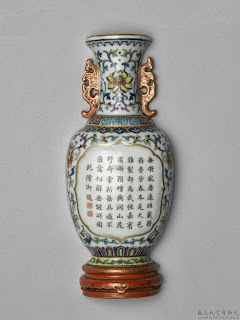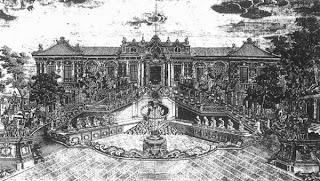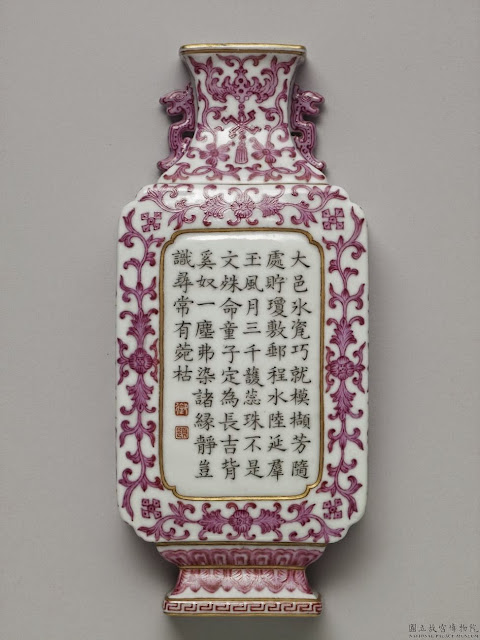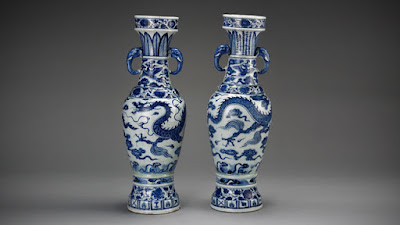Qianlong Famille Rose Porcelain "Wall Pockets" For Sedan Chairs
 |
| Qianlong Famille Rose Sedan Vase, 18th C. |
18th C. China's Period of Enlightenment
During the 18th C. under the reign of the Qianlong Emperor (1735-1795) the arts and government support of the arts in China reached a level of patronage like no other in the history of the country.
Like his grandfather the Kangxi Emperor he was fascinated in scholarly pursuits and above all else valued education and as the singularly most important pursuit a man could have. Qianlong was in his early days fascinated by science and mathematics as well as being a well know poet in his own right, who like Kangxi was a connoisseur of fine calligraphy and early paintings. The both were voracious collectors.
During Qianlong's long rule China's wealth grew massively with an expanding productive population and ever increasing global trade, leading to a vast amount of economic intercourse with the west.
Ship's from around the globe plied the waters to China's port of Canton to trade for all manner of goods from spice, sugar, tea and silks to luxury goods including fine porcelains. Canton was in it's day perhaps the most economically active city on earth.
 |
| Qianlong Period Famille Jaune Sedan vase |
Qianlong, An Era of Opulence
All of this trade and resulted in a flood of gold from the west into China. This rapid amassing of uncountable wealth removed all limits on Imperial patronage. During these years the palace routinely ordered thousands of pieces of porcelain on an annual basis and encouraged potters and decorators to experiment without constraint with color combinations, shapes
and sizes. Large scale projects were undertaken for superb buildings, new roads, schools and numerous palaces including
the Yuanmingyuan (Garden of perfect splendor or perfect brightness) also known as The Summer Palace.
Craftsmen were encouraged to cultivate unsurpassed skills in metal working, jade carving, cloisonne and classical painting and of course calligraphy. Calligraphy was in itself viewed as an important deeply traditional art form, total competency was a pre-requisite for any scholar.
 |
| Qianlong's Imperial Summer Palace, The Yuanmingyuan |
The Imperial Kilns of Jingdezhen
The 18th C. was a period of unprecedented technical perfection in the making of fine porcelain along with the predictable production of the widest range of possible coloring techniques ever seen. This was especially true at the Imperial kilns who were tasked with furnishing and delighting the emperor with with one newly invented form after another. |
| Qianlong Period Famille Rose Sedan Vase |
conflicts and not the output of the porcelain's quality. Tang Ying retired in 1756 and died that year.
He left behind an important legacy of creativity, innovative potting techniques, as well as an astounding variety of new possibilities with the application of colors.
Most particularly were the still famous Famille Rose enamels which enabled unsurpassed options for decorating all forms and shapes of porcelain. These enamels could be applied, shaded and blended to achieve nearly any result a traditional painter on canvas could create. Porcelain could now be decorated like a traditional painting.
_____________________________________________________________________
 |
| Click Image & sign up, it's Free |
__________________________________________________________________________
 |
| Late 19th C. Chinese Wedding Sedan Chair |
Sedan Chair Wall Vases
 |
| 19th C. Chinese Middle Class Sedan Chair |
As the name implies they were originally made to be hung on the walls of a Sedan, which resembled a small house and was carried by servants while some fortunate individual rode along inside, protected from the mud and muck so common Chinese roads..
As an amusement these charming and (for the Imperial house) sublimely fine flattened vases were hung in pairs often filled with some fresh flowers. Giving the passenger something pleasant to to look at and enjoy while travelling. The flowers also acted as a welcome scent given the septic circumstances at the time.
This very finest examples would have panels of
flowers with blank area's filled with rows of script expressing a poem. Often composed by a favorite poet or the emperor himself.
The very finest examples bore the seal mark of Qianlong .
Today these are highly sought after by collectors from around the world and a favorite among Imperial porcelain fans.
NOTE: All of the examples being shown here are in the National Palace Museum Collection in Taiwan.
 |
| Fine Imperial Qianlong Sedan vase, with Upper Imperial Nien Ho and Poem |
 |
| Fine Imperial Qianlong Sedan vase, with Poem |
 |
| Fine Imperial Qianlong Sedan vase, with Poem |
 |
| Fine Imperial Qianlong Sedan vase, with Upper Imperial Nien Ho and Poem |


Qianlong Famille Rose Porcelain "Wall Pockets" For Sedan Chairs >>>>> Download Now
ReplyDelete>>>>> Download Full
Qianlong Famille Rose Porcelain "Wall Pockets" For Sedan Chairs >>>>> Download LINK
>>>>> Download Now
Qianlong Famille Rose Porcelain "Wall Pockets" For Sedan Chairs >>>>> Download Full
>>>>> Download LINK J5